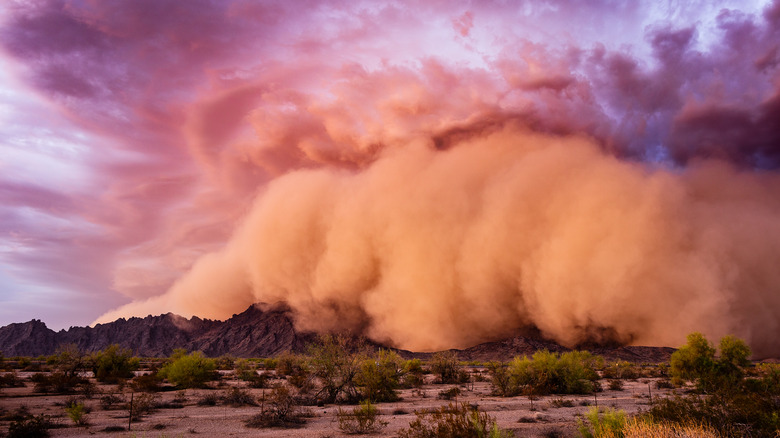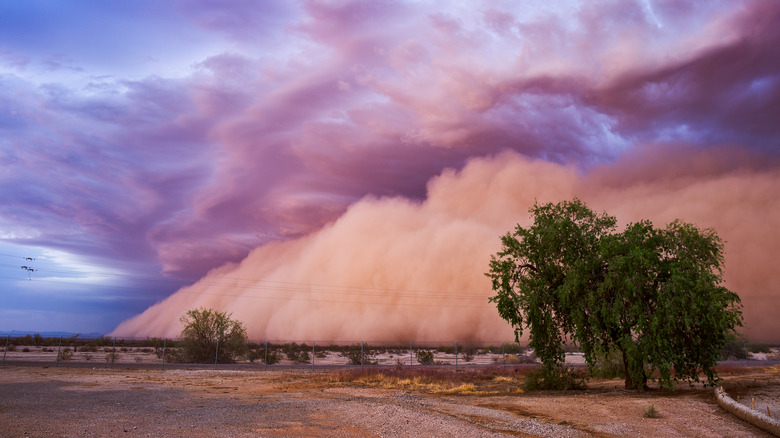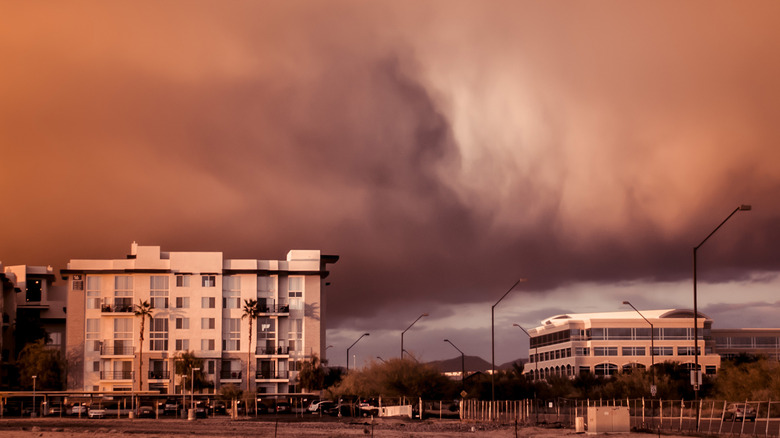What Is A Haboob?
In early December 2022, CNN reported that the Western United States had braced for a series of winter storms, with up to 2 feet of snow in some mountain areas. Along with freezing temperatures, high winds were expected. The region, long experiencing drought, could also see increased fire danger from a mix of low humidity, high winds, and warm temperatures that precipitate an advancing cold front. Along with that report, CNN explained that those winter storms anticipated in the West could also produce a serious type of storm called a haboob.
As Britannica notes, haboobs typically happen in the South Sahara and Sudan along with a thunderstorm. They also often happen in the spring and summer months in parts of the American Southwest, according to the National Oceanic and Atmospheric Association. Although those two parts of the world mentioned aren't commonly thought of as having winter weather, the confluence of unique atmospheric conditions expected in the Western United States, such as thundersnow (or thunder with snow instead of rain) could make this weather event happen out of season.
A haboob is a dust storm
As NOAA goes on to note, a haboob is a type of dangerous dust storm that can sometimes engulf a city skyline, as was the case in 2012 when a haboob struck Phoenix, Arizona. The word haboob comes from the Arabic word "haab," translating to wind or blow in English. Most often, as a thunderstorm approaches a region, air gets pushed down to the ground, filled with particulates. As wind speeds increase, additional debris gets whipped-up in the storm as a towering wall of dust is created.
These dust storms can reach as tall as 10,000 feet and cover an entire area in darkness for as long as 30 minutes. In addition to the parts of the world already mentioned, haboobs happen in the American Sonoran desert, the Gulf of Guinea, and elsewhere in North Africa. Though the word haboob may sound strange, they're not that uncommon and they're increasing in frequency in ongoing drought conditions.
As Popular Science explains, haboobs are particularly dangerous for animals and individuals with respiratory or cardiovascular issues. And as University of Oklahoma meteorologist Jason Furtado points out (via PopSci), not just any sandstorm qualifies. "Every haboob is a sandstorm, but not every sandstorm is a haboob," Furtado said. By definition a haboob must also be accompanied by a thunderstorm or, as in the late 2022 winter weather prediction, thundersnow.
Temperatures climb in advance of cold weather
Though at first it may seem contradictory that a weather event common to hot, arid climates could occur along with two winter storms expected to produce many feet of snow at high elevations, temperatures do increase as cold fronts advance. That fact, combined with winter storm winds expected to reach in excess of 80 mph and ongoing drought conditions, a haboob could happen during winter.
Wildfire risk was also expected, per CNN. Should a haboob result from the two Western winter storms predicted, Goodland Weather Service, in Goodland, Kansas, said to expect (via CNN) "[L]ess than 1 mile visibility likely until the wall of dust passes."
As of CNN's report, the winter storm warning stretched across 17 U.S. states, affecting more than 25 million people. For a number of reasons, as Popular Science notes, from a changing climate to worsening soil degradation, haboobs now happen more frequently. On the potential for more haboobs in the future, meteorologist Jason Furtado said (via PopSci), "It keeps cycling down that path [toward haboob conditions], getting drier and drier. It just spirals down."


